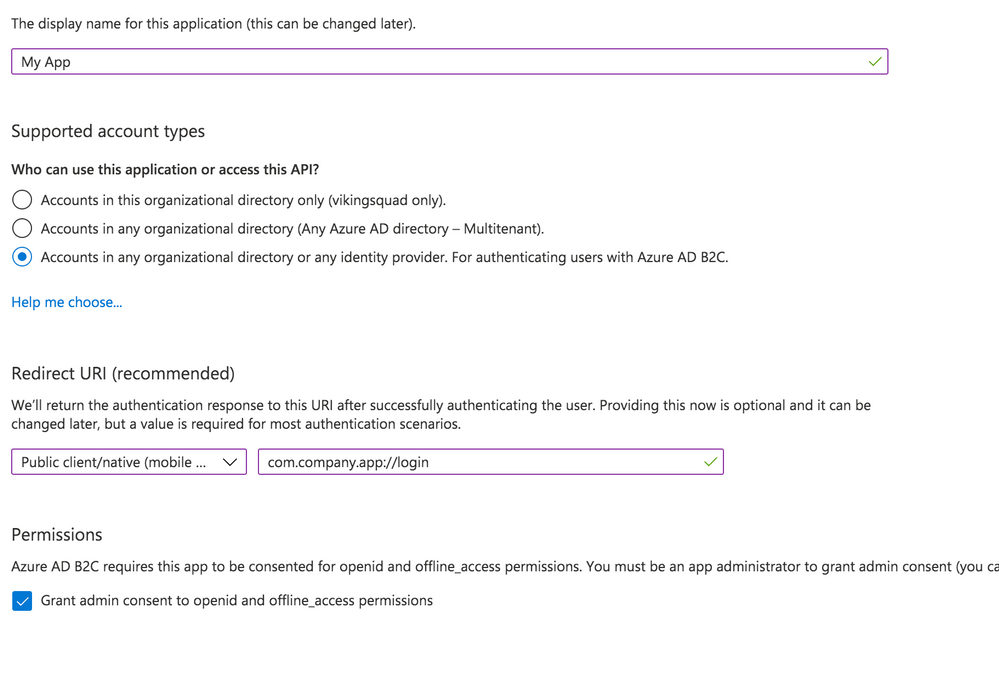
by Scott Muniz | Aug 10, 2020 | Azure, Microsoft, Technology, Uncategorized
This article is contributed. See the original author and article here.
Azure Active Directory B2C (Azure AD B2C) is a great way to enable secure authentication for your users across mobile and web — from basic sign-in and sign-out, to profile management and more.
While Azure AD B2C is designed to work well on any iOS or Android phone or tablet, integrating with any auth provider can be particularly tricky on a mobile device, particularly if you’re building a “hybrid” mobile app using something like Cordova or Capacitor. Issues like secure token storage, Man-In-The-Middle attacks, and timely security updates can be troublesome, and create risks if not handled properly.
That’s why the Ionic team designed Auth Connect. Ionic Auth Connect makes it easy to add secure authentication to any hybrid mobile app running on iOS, Android, or the web. Using a simple, powerful API, it handles logging in and/or registering a user with an authentication provider (such as Azure Active Directory) using industry-standard OAuth/OpenId Connect.
Getting Started
In this tutorial, we’ll add login/logout functionality to a basic Ionic app by integrating Ionic Auth Connect. There’s only a few steps required to implement Auth Connect with Azure AD B2C in an Ionic app: configure Azure AD B2C, install Auth Connect in an Ionic app, and configure Auth Connect to use Azure AD B2C.
To begin, clone this repository and follow along. The “start” folder contains the basic structure of the app that we’ll make changes to and the “completed” folder contains the finished app as a reference point if needed.
NOTE: An Ionic Native Enterprise Edition key is required in order to install and use the Ionic Auth Connect plugin. Ionic Native Enterprise features a library of Premier plugins and solutions that are fully supported and maintained by the Ionic team, with access to Ionic experts and a guaranteed response SLA to mission-critical app development. If you are interested in acquiring a key or learning more, please contact us here.
To see what Ionic Auth Connect looks like in action, view this short video.
After cloning the code, do the following:
1. Install the Ionic CLI:
npm install -g @ionic/cli
2. In a terminal, change directory into the “start” folder in the repository:
cd demo-authconnect-azureb2c/start
3. Run npm install. NOTE: This will fail if an Ionic Native key hasn’t been registered.
4. Run ionic serve to build and serve the app locally in a web browser.
The Reference App
The Ionic app is a modified version of a blank Angular starter project. It consists of two pages: the Home page displays the signed-in user’s details (which will be retrieved from Azure AD B2C) and the Login page protects the Home page from unauthorized access.
Azure Active Directory B2C Configuration
Before integrating Auth Connect into the Ionic app, you’ll need to get Azure Active Directory (AD) B2C up and running.
Note: For complete information on configuring Azure AD, consult the official B2C documentation which includes tutorials on creating a B2C tenant, registering applications, and more.
Create an Azure AD B2C Tenant
If you don’t have one, create a new B2C tenant.
Register an Application
Sign into the Azure Portal then navigate to the Azure AD B2C service page.
Begin by creating a new Application under Manage – App registrations – New registration.

Give your app a new name, then select the Supported Account Types.
With that in hand, set the Redirect URI. Choose “Public client/native (mobile & desktop)” – we’ll add web support in a separate step. Then, fill in the text field value with your globally unique App Id, which is used both in the Azure configuration as well as the native mobile app’s configuration. Typically, this takes the form of company-AppName or reverse DNS style – com.company.app. Use the formula “uniqueId://page”. After the app user signs into Azure AD, this tells Auth Connect which page to redirect to in your app. While any page can be used, in this example we’ll use the Login page, such as com.company.app://login. Click the register button to create the app.
Add Web Platform
With the app created, navigate to Manage – Authentication. Click the “Add a Platform” button. Under Web applications, choose “single-page application.”
Under Redirect URIs, specify a web URL. In this example, for local testing, we’ll use http://localhost:8100/ along with the name of your app’s core login page (typically, login).
Next, under Logout URL, specify a web URL to redirect to once the user has logged out of your app. Again, for local testing, specify https://localhost:8100/ along with the name of the logout page (typically logout).
Finally, under Implicit Grant, toggle “Access tokens.” Click the Configure button to save.

Back on the Authentication page, look under the Single-page application settings. Click the “Add URI” button to add additional Redirect URIs, including those for other environments like staging or production. Click Save when ready.

Expose an API
Navigate to the “Expose an API” page. Click “Add a scope”, then for the Scope name, provide a value such as “user_impersonation.” For the display name and description fields, add details describing that this is for authenticating your users. Set the state to enabled then click the “Add scope” button.
Configure API Permissions
Next, we need to authorize our app so it can connect to Azure B2C and retrieve user profile information alongside login credentials. Navigate to the API Permissions page then click the “Add a permission” button. Under “Select an API”, choose “My APIs” then click the name of the B2C app we’re currently configuring. Next, select the “user_impersonation” permission (or whatever name you labeled it in the previous step) then click the “Add permissions” button.
Save the application, then click on the newly added permission row. Click the “Grant admin consent for [your organization name]” button then choose “Yes.”

Click on the “user_impersonation” permission row again to open the modal window, then click to copy the link that is displayed. Note this URL, because it will be used as part of Auth Connect’s “scopes” property later.
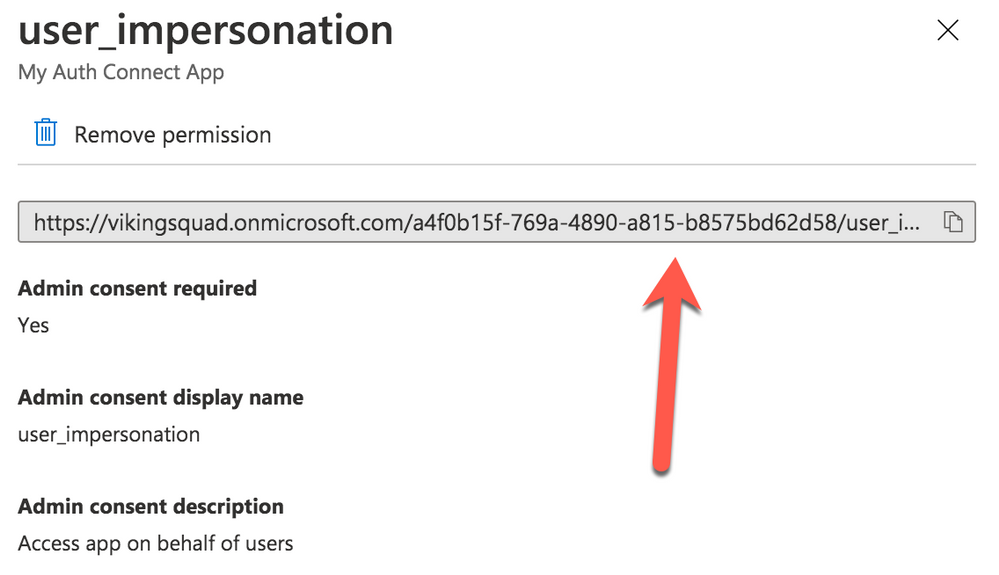
Create User Flows (Policies)
Create at least one User Flow, the series of pages that define the entire authentication experience for your app. At a minimum, create a Sign up and sign in flow. Once the User Flow has been created, select it from the User Flow list, then click “Run user flow” from the Overview tab. Note the URL at the top of the page, used to configure Auth Connect’s Discovery URL property.
Azure AD B2C is now ready to use with Auth Connect.
Install Auth Connect
Auth Connect works on the web or on mobile. For deploying to mobile, we’ll use Capacitor, Ionic’s cross-platform native runtime for building native mobile and web apps, using JavaScript, HTML, and CSS, with one shared codebase. Learn more about the project and how to deploy this Ionic app to mobile here.
Adding Capacitor is easy:
ionic integrations enable capacitor
Run the following command to install the Auth Connect plugin. For the AUTH_URL_SCHEME variable, use the globally unique App Id (ex: com.company.app) you decided on when configuring the Azure AD app above.
npm install @ionic-enterprise/auth --variable AUTH_URL_SCHEME=com.company.app
npx cap sync
Configure Auth Connect
Configuring Auth Connect involves two steps: adding configuration details into the app from your Azure AD tenant and implementing login/logout functionality.
Azure Configuration Details
Since the Azure AD B2C app will support different values per environment (typically staging, QA, production, etc.) we can support that in the Ionic app using Angular’s environments. Open src/environments/environment.ts then add the following. We’ll begin with a web-based configuration since it’s easier to build and test locally in a browser:
import { IonicAuthOptions } from '@ionic-enterprise/auth';
export const azureWebConfig : IonicAuthOptions = {
// the auth provider
authConfig: 'azure',
// The platform which we are running on
platform: 'web',
// client or application id for provider
clientID: 'FILL_IN',
// the discovery url for the provider
// OpenID configuration
discoveryUrl: 'FILL_IN',
// the URI to redirect to after log in
redirectUri: 'http://localhost:8100/login',
// requested scopes from provider
scope: 'openid offline_access email profile FILL_IN',
// the URL to redirect to after log out
logoutUrl: 'http://localhost:8100/login',
// Show provider login in either current window or new tab
implicitLogin: "CURRENT"
};
Some of these `IonicAuthOptions` values are unique and must be set based on the Azure AD app that we just created above:
* platform: Use “web” if running as a PWA or “capacitor” when the app is deployed as an iOS or Android app.
* clientID: Your app’s _Application (client) ID_, found on the Overview page. Example: cebbb0be-d578-4bbd-9712-4b0fe05c06aa
* redirectUri: The URI to redirect to after the user has logged in. Since we’re testing locally in a browser, use “http://localhost:8100/login” since this is what `ionic serve` runs on.
* logoutUrl: The URI to redirect to after the user has logged out. Again, use “http://localhost:8100/”.
The scope property is used to unlock access to protected resources, such as read/write permissions. There’s a variety of attributes available; an example looks like: “openid offline_access email profile”.
In addition to the values above, add the Full Scope Value link created earlier to the `scope` property. To find it in the Azure AD B2C portal, navigate to the “Expose an API” page then click on the Scope you defined earlier. In the modal window, copy the link that appears under “Scope name.” All together, it will look similar to this:
scope: 'openid offline_access email profile https://orgname.onmicrosoft.com/api/user_impersonation',
The discoveryUrl can be found by navigating to the main Azure AD B2C page -> Policies -> User flows -> [Select User Flow] -> Overview tab -> Run user flow button. The discovery link is at the top of the page and will look like the following format:
https://B2C-TENANT-NAME.b2clogin.com/B2C-TENANT-NAME.onmicrosoft.com/v2.0/.well-known/openid-configuration?p=POLICY-NAME
Where B2C-TENANT-NAME is your tenant name and the POLICY-NAME is the name of the User Flow created earlier.
The native mobile configuration is almost the same as the web. Make a copy of the web configuration then change the redirect and logout urls. Use the same AUTH_URL_SCHEME variable value (App Id) from when the Auth Connect plugin was installed. For example, “com.company.app://” plus the name of the Login page. Change the platform to “capacitor”:
export const azureNativeConfig : IonicAuthOptions = {
platform: 'capacitor',
redirectUrl: 'com.company.app://login',
logoutUrl: 'com.company.app://logout'
// snip - other variables
}
Create an Authentication Service for Login Functionality
With Azure AD environment configurations added to the Ionic app, we can now leverage them in an AuthenticationService class that encapsulates Azure AD and Ionic Auth Connect’s login functionality.
Generate this class using the ionic generate command:
ionic generate service services/authentication
Open up src/app/services/authentication.service.ts and import Auth Connect, RxJs (for tracking login status changes), and the Azure AD configuration objects we just created:
import { Injectable } from '@angular/core';
import { Platform } from '@ionic/angular';
import { IonicAuth } from '@ionic-enterprise/auth';
import { Subject, Observable } from 'rxjs';
import { azureNativeConfig, azureWebConfig } from '../../environments/environment';
Next, extend the IonicAuth class in order to gain access to Auth Connect’s functionality, and in the constructor, instantiate it with the proper Azure configuration object. Using Ionic’s Platform API, we can dynamically choose which configuration to use based on whether the app is running on the web or a mobile device.
export class AuthenticationService extends IonicAuth {
constructor(platform: Platform) {
// Determine whether to run on mobile or the web
const selectedConfig = platform.is('hybrid') ? azureNativeConfig : azureWebConfig;
super(selectedConfig);
}
Implementing login functionality is quite simple – we define our own login method then call Auth Connect’s login method.
async login(): Promise<void> {
await super.login();
}
Upon successful login, Auth Connect calls the `onLoginSuccess` event, which we can override here to run any additional logic we need. In this case, we can emit an RxJs event when the login status changes (either logged in or logged out) then react accordingly (direct the user into the app or back to the Login page).
onLoginSuccess() {
this._loginStatusChanged.next(true);
}
Define the status change observable right below the class definition:
// Emit event when login status changes
private _loginStatusChanged: Subject<boolean>;
get loginStatusChanged(): Observable<boolean> {
return this._loginStatusChanged.asObservable();
}
To detect and act on the login status changing, head over to `app.component.ts` in `src/app`. Import the AuthenticationService class, then subscribe to the status change observable:
import { AuthenticationService } from './services/authentication.service';
// snip
constructor(
private auth: AuthenticationService,
private navController: NavController,
private platform: Platform
) {
this.initializeApp();
this.auth.loginStatusChanged.subscribe(authenticated =>
this.handleAuthChange(authenticated));
}
Next, add a method that inspects the status of the login attempt. If successful, redirect the user to the Home page, otherwise, remain on the Login page:
private handleAuthChange(authenticated: boolean) {
if (authenticated) {
this.navController.navigateRoot(['home']);
} else {
this.navController.navigateRoot(['login']);
}
}
The last step is easy: leveraging the AuthenticationService from the Login page (`src/app/login/login.page.ts`). First, add a click handler to the Login button:
<ion-button (click)="login()" strong shape="round">
Log in
</ion-button>
Next, add a new method to call the AuthenticationService’s login method:
async login() {
await this.authService.login();
}
Just one last step required. When running as a web app, the user will be redirected to the Azure AD sign-in page. After successful sign-in, they’ll be sent back to the Ionic app and since this is a “fresh” load of the page, we need to pass the access token along to Auth Connect. To do so, pass the browser’s url to Auth Connect’s `handleCallback` function:
async ngOnInit() {
if (window.location.hash) {
await this.authService.handleCallback(window.location.href);
}
}
Once handleCallback completes, Auth Connect will call `onLoginSuccess()` in the AuthenticationService class, which triggers the login status change event, ultimately permitting the user access to the Home page.
That’s it! Click the Login button in the browser, sign in using your Azure AD B2C credentials, then you should be redirected to the Home app.
View Azure AD User Details
Logging in is nice, but what if we took it one step further by displaying some of the Azure AD user’s profile details on the Home page?
Back over in the AuthenticationService, declare a new method to retrieve the user’s profile info from Azure. Access all information via Auth Connect’s `getIdToken` function:
async getUserInfo() {
const idToken = await this.getIdToken();
if (!idToken) {
return;
}
let email = idToken.email;
if (idToken.emails instanceof Array) {
email = idToken.emails[0];
}
return {
id: idToken.sub,
email: email,
firstName: idToken.given_name,
lastName: idToken.family_name,
picture: "assets/user-placeholder.jpg"
};
}
Next, over in the Home page (`src/app/home/home.page.ts`), make the call to `getUserInfo` when the page loads:
user: any;
constructor(private authService: AuthenticationService) { }
async ngOnInit() {
this.user = await this.authService.getUserInfo();
}
To complete this, update the Home page’s HTML template so that it now displays the user’s profile info:
<ion-content>
<div class="ion-padding">
<div align="center" *ngIf="user">
<ion-avatar>
<img src="{{ user.picture }}">
</ion-avatar>
<p>{{ user.firstName}} {{ user.lastName }}</p>
<p>{{ user.email }}</p>
</div>
<ion-button expand="block" (click)="logout();" style="margin-top: 50px">Log out</ion-button>
</div>
</ion-content>
If you’re still running `ionic serve`, save all files, then the page should reload, displaying your Azure AD user profile details.
Implementing Log Out
The last step is to add logout functionality. Since we’re already in the Home page code, add a new function that calls Auth Connect’s `logout` function directly:
async logout() {
await this.authService.logout();
}
Back over in AuthenticationService, implement Auth Connect’s “onLogout” event, which fires once it has successfully logged out the current user. All the app needs to do is fire the login status changed event, passing “false” to indicate that the user is no longer logged in:
onLogout() {
this._loginStatusChanged.next(false);
}
Recall that this event will be caught over in `app.component.ts`, and since “authenticated” is now false, the user will be redirected to the Login page:
private handleAuthChange(authenticated: boolean) {
if (authenticated) {
this.navController.navigateRoot(['home']);
} else {
this.navController.navigateRoot(['login']);
}
}
Reload the page, click the Logout button, and you should be signed out then redirected to the Login page.
What’s Next?
In just a few steps, we added Azure AD B2C authentication to an Ionic app, with complete login and logout functionality. With Auth Connect now in place, there are many paths to go from here. You can further tweak the Azure AD user experience (such as customizing the user interface) or begin testing Auth Connect in a native app right away.
About Ionic Auth Connect
Auth Connect is built and maintained by the Ionic team. Ionic makes tools and services that empower web developers to deliver stunning native mobile and web applications, using the web tools, libraries, and frameworks that they know and love. Our cross-platform native runtime, Capacitor, provides a secure way to deliver web-based applications on a mobile device. When coupled with Ionic’s Auth Connect solution, implementing single sign-on in web applications is even easier.
Happy app building!

by Scott Muniz | Aug 10, 2020 | Alerts, Microsoft, Technology, Uncategorized
This article is contributed. See the original author and article here.
|
We continue to expand the Azure Marketplace ecosystem. For this volume, 90 new offers successfully met the onboarding criteria and went live. See details of the new offers below:
|
Applications
|
 |
Akenza Core- IoT made simple: Akenza Core on Microsoft Azure is an easy-to-use enterprise IoT system designed to help companies and cities build real-time connected solutions and add any type of device or technology to it.
|
 |
Aparavi, The Platform: Aparavi is a cloud-based data intelligence and automation platform that empowers organizations to find, control, and unlock the value of their data. Built on Microsoft Azure, Aparavi ensures secure access for analytics, machine learning, and collaboration.
|
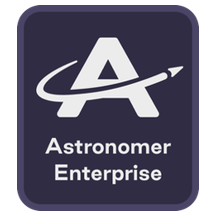 |
Astronomer: Astronomer enables users to easily spin up, deploy code to, and configure isolated Apache Airflow environments on Microsoft Azure Kubernetes Service clusters. It includes a full Prometheus and Grafana monitoring stack, user permission control, and a flexible logging system for full-text log search.
|
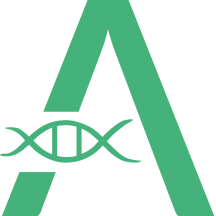 |
Atgenomix SeqsLab: Atgenomix SeqsLab creates and manages elastic Spark clusters and a parallel file system, installs container-based pipelines, and schedules tasks to execute on CPU/GPU cores. Researchers can use it as a bio-IT platform service to build DNA/RNA workflows where large-scale execution is required.
|
 |
Barracuda CloudGen WAN Service: Barracuda CloudGen WAN is a cloud-delivered service combining the benefits of next-generation firewalls, secure SD-WAN, cloud integration, and automation to deliver a practical Secure Access Service Edge (SASE) solution on Microsoft Azure.
|
 |
Better Platform: Better is an open electronic health record (EHR) data platform designed to store, manage, query, retrieve, and exchange structured EHR data. Retrieve relevant patient information in the right place at the right time to promote safe and efficient care.
|
 |
Bitdefender GravityZone Elite – BYOL: Bitdefender’s GravityZone Elite detects and prevents sophisticated cyber threats with a proven layered approach and next-gen, non-signature technologies that stop techniques such as ransomware, zero-day malware, fileless attacks, script-based attacks, targeted attacks, and grayware.
|
 |
braincure: Available only in Japanese, the braincure smartphone application on Microsoft Azure is designed to promote improved health and wellness among the elderly.
|
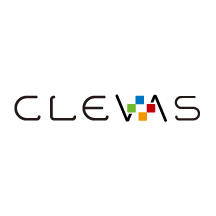 |
CLEVAS: CLEVAS is a video sharing platform that allows users to add comments to, rate, share, and analyze educational videos. It supports learning activities such as university lectures, medical practices, corporate education, and training seminars. This app is available only in Japanese.
|
 |
Dataguise for Azure Marketplace: Dataguise monitors access to elements containing raw, sensitive data; provides thorough identity inventory and classification of sensitive data; and delivers back-end automation of data subject requests for privacy standards such as PII, PCI, HIPAA, CCPA, and GDPR.
|
 |
DxEnterprise for Availability Groups (AGs): DxEnterprise for Availability Groups (AGs) enables SQL Server AGs to be made highly available within and between Windows and Linux nodes and across any type of infrastructure – all without relying on other cumbersome, restrictive cluster orchestration technologies.
|
 |
Expert Integrator for Power Platform: Expert Integrator for Power Platform integrates and rationalizes Salesforce data and presents it in an industry-specific format in Microsoft Power Platform, enabling rapid low-code/no-code development, app coexistence, and integration with Dynamics 365 and other Microsoft services.
|
 |
FileCloud on Red Hat Linux: CodeLathe’s FileCloud on Red Hat Linux allows businesses to host their own branded file-sharing, sync, and backup solution on Microsoft Azure for employees, partners, and customers. It provides secure, high-performance backup across all platforms and devices with unlimited file versioning.
|
 |
FlexProtect for Apps: Imperva’s FlexProtect application security is a SaaS solution that provides multi-layered defenses to protect Microsoft Azure-hosted workloads and applications from attacks while ensuring an optimal user experience.
|
 |
Fortinet FortiGate Next-Generation Firewall: Fortinet FortiGate firewall technology delivers complete content and network protection by combining stateful inspection with a comprehensive suite of powerful security features. Identify and mitigate the latest complex security threats with FortiGate on Microsoft Azure.
|
 |
Fortinet FortiWeb Web Application Firewall WAF VM: Fortinet FortiWeb web application firewalls provide advanced features and AI-based machine learning detection engines that defend web applications from vulnerability exploits, bots, malware uploads, denial-of-service attacks, advanced persistent threats, and zero-day attacks.
|
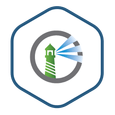 |
Harbor Adapter Trivy Container Image: Harbor Adapter for Trivy translates the Harbor API into Trivy API calls and allows Harbor to provide vulnerability reports on images through Trivy. Bitnami packages applications following industry standards and continuously monitors all components and libraries for vulnerabilities.
|
 |
Hexplora Healthcare Analytics: Hexplora’s cloud-based Healthcare Analytics solution on Microsoft Azure is made for small-to-midsize risk-bearing healthcare entities entering value-based contracts. It provides insights that can help healthcare organizations reduce costs and improve quality.
|
 |
Horizon: SecuriThings’ Horizon is an IoTOps software-only solution that brings IT standards to the realm of IoT by providing risk detection, predictive maintenance, and automated operations. Protect IoT devices while maximizing operational efficiency in one unified view.
|
 |
Identity and Data Governance for Multi-cloud: The Dig platform from Sonrai Security delivers a complete risk model of all identity and data relationships in public clouds, including activity and movement across cloud accounts, cloud providers, and third-party data stores.
|
 |
IIS on Windows Server 2016: This image from Skylark Cloud includes Internet Information Services (IIS) and Windows Server 2016. IIS is a flexible and secure web server for hosting anything on the web, from streaming media to web applications. IIS features scalable and open architecture that is ready to handle the most demanding tasks.
|
 |
IIS on Windows Server 2019: This image from Skylark Cloud includes Internet Information Services (IIS) and Windows Server 2019. IIS is a flexible and secure web server for hosting anything on the web, from streaming media to web applications. IIS features scalable and open architecture that is ready to handle the most demanding tasks.
|
 |
Innovaccer’s COVID-19 Management system: Innovaccer’s COVID-19 Management System enables practices to more easily and efficiently manage and screen high volumes of patients. Innovaccer features a robust set of security policies, procedures, and controls to ensure full compliance with HIPAA requirements.
|
 |
JRuby Container Image: JRuby is a Java implementation of the Ruby programming language that provides core built-in classes and syntax for Ruby. Bitnami packages applications following industry standards and continuously monitors all components and libraries for vulnerabilities and application updates.
|
 |
Kong Helm Chart: Kong is an open-source microservice API gateway and platform designed for managing microservice requests to high-availability, fault-tolerant, and distributed systems. Bitnami ensures its Helm charts are secure, up to date, and packaged using industry best practices.
|
 |
LTI Security in a Box: LTI’s Security in a Box solution provides a comprehensive security stack to support simple to complex operating environments and requirements, simplified security choices with easy cloud adoption, a zero-trust security framework based on NIST standards, and more.
|
 |
Maintenance Management Solution for Solar Plants: Designed for solar operators and maintenance providers, this SharePoint maintenance management solution from WIZSP offers a flexible work environment that allows workers to collaborate seamlessly from anywhere on any device.
|
 |
MATLAB Production Server (PAYG): MATLAB Production Server is an application server for integrating MATLAB analytics into web, database, and production enterprise applications running on dedicated servers or on Microsoft Azure.
|
 |
Matomo with Windows Server 2016: This image from Skylark Cloud includes Matomo, formerly Piwik, and Windows Server 2016. Matomo is a free and easy-to-use open-source web analytics application offering complete data ownership, user privacy protection, GDPR compliance, and more.
|
 |
Matomo with Windows Server 2019: This image from Skylark Cloud includes Matomo, formerly Piwik, and Windows Server 2019. Matomo is a free and easy-to-use open-source web analytics application offering complete data ownership, user privacy protection, GDPR compliance, and more.
|
 |
ModernFlow: ModernFlow is an integrated process automation solution that uses Microsoft Azure and Office 365 to automate, streamline, and optimize business processes to help reduce costs, add control, and improve productivity.
|
 |
Nuventive COVID-19 Response Hub: Nuventive’s COVID-19 Response Hub is a quick-start cloud solution with a framework to bring your institution’s COVID-19 plan to life. Survey faculty and staff on their welfare with results linked to your plan in Nuventive.
|
 |
OneCore Smart Calculation Engine: OneCore Smart Calculation Engine allows organizations to replace different calculation engines with one central solution. This change supports a “one truth” vision where all calculations in ERP, CRM, and purpose-built systems use the same calculation mechanisms to calculate financial products.
|
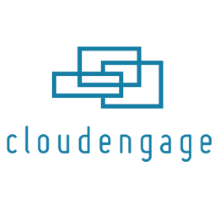 |
Personalization Platform: CloudEngage helps you give your customers personalized, relevant, and intuitive experiences when they visit your website. CloudEngage works seamlessly with any CMS or commerce system to help increase your web and mobile conversion rates.
|
 |
Photron-Mobile Video Creator: Photron-Mobile Video Creator is an iPhone/iPad video production and editing application that organizations use to document and share technology transfer, video manuals, work procedures, safety education, internal communications, and more. This app is available only in Japanese.
|
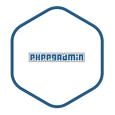 |
phpPgAdmin Container Image: phpPgAdmin is a free software tool written in PHP for handling PostgreSQL database administration over the web. Bitnami packages applications following industry standards and continuously monitors all components and libraries for vulnerabilities and application updates.
|
 |
Platform Security (CA): New Signature’s Platform Security managed service complements and integrates with your IT services, enabling your team to focus on providing great user support and working on initiatives that deliver significant business value.
|
 |
Prometheus RSocket Proxy Container Image: Prometheus RSocket Proxy is a collection of resources used to get application metrics into Prometheus using a bidirectional, persistent remote procedure call (RPC) without ingress.
|
 |
QuickStart: QuickStart is a cloud readiness platform that uses AI, adaptive learning, and multimodality delivery to personalize employee learning and engagement. QuickStart also accelerates Microsoft Azure or multi-cloud enablement and certification.
|
 |
ResFrac Hydraulic Fracturing Reservoir Simulator: ResFrac is an integrated hydraulic fracturing and reservoir simulator that can model the well lifecycle from treatment through production. The three-dimensional compositional simulator seamlessly couples hydraulic fracturing, wellbore, geomechanical, and reservoir simulation.
|
 |
Riversand PIM-MDM for Manufacturing & CPG: Riversand’s Master Data Experience Platform for manufacturing and consumer packaged goods addresses the master data-related challenges typically encountered when organizations digitize the information value chain and enhance their omnichannel product experience for customers.
|
 |
School Day Wellbeing for Individual Schools: School Day supports students’ well-being in real time by delivering anonymous well-being data that supports decision-making in schools and empowers the school community to focus on learning.
|
 |
ScrumGenius – Automate daily standups: ScrumGenius automates team status meetings to help managers track the progress, goals, and performance of their employees. It integrates with third-party tools such as Jira, GitHub, and Microsoft Azure DevOps Services to display team activity along with each member’s status updates.
|
 |
SharpCloud Subscriptions: SharpCloud connects people, data, and processes to create dynamic threads across a business, revealing valuable insights that can be analyzed in real time. Collaborate around data-driven stories that offer a clear view of key metrics, time, relationships, and costs across projects and portfolios.
|
 |
Spring Cloud Data Flow Container Image: Spring Cloud Data Flow is a microservices-based toolkit for building streaming and batch data processing pipelines in Cloud Foundry and Kubernetes. Bitnami packages applications following industry standards and monitors components and libraries for vulnerabilities and application updates.
|
 |
Spring Cloud Data Flow Shell Container Image: Spring Cloud Data Flow Shell is a tool for interacting with the Spring Cloud Data Flow server. Bitnami packages applications following industry standards and continuously monitors all components and libraries for vulnerabilities and application updates.
|
 |
Spring Cloud Skipper Container Image: This package manager installs, upgrades, and rolls back Spring Boot applications on multiple cloud platforms. Bitnami packages applications following industry standards and continuously monitors all components and libraries for vulnerabilities and application updates.
|
 |
Spring Cloud Skipper Shell Container Image: Spring Cloud Skipper Shell is a tool for interacting with the Spring Cloud Data Skipper server. Bitnami packages applications following industry standards and continuously monitors all components and libraries for vulnerabilities and application updates.
|
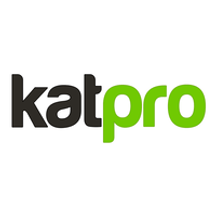 |
Sukra Industrial Platform: Based on flexible microservices, sukra.io is a fully customizable, enterprise-grade IoT platform that scales with the needs of any business and supports advanced deployment models for multi-cloud IoT solutions.
|
 |
TwinWorX – Centralized Monitoring and Control of Facilities: TwinWorX is a scalable and secure platform that integrates and normalizes all telemetry data into a single platform, resulting in increased operational visibility while providing real-time and historical data for visualization, reporting, analytics, optimization, and more.
|
 |
Visual Diagnostics: Vastmindz uses AI, computer vision, and signal processing technology to turn any device with an embedded camera into a non-invasive diagnostic tool that displays information about an individual’s heart rate, respiration rate, oxygen saturation levels, stress levels, and more.
|
 |
WAULT: The WAULT platform provides secure and verifiable data exchange between users and companies involved in business transactions without compromising privacy or data control. It’s ideal for storing and sharing verified documents that you don’t want changed.
|
 |
WAULT Portal for Businesses and Individuals: This is the trial version of the WAULT platform from Wymsical Inc. WAULT provides secure and verifiable data exchange between users and companies involved in business transactions without compromising privacy or data control.
|
 |
WordPress with Windows Server 2016: This image from Skylark Cloud includes WordPress and Windows Server 2016. WordPress is a free and open-source content management system used for websites, blogs, and applications.
|
 |
WordPress with Windows Server 2019: This image from Skylark Cloud includes WordPress and Windows Server 2019. WordPress is a free and open-source content management system used for websites, blogs, and applications.
|
Consulting services
|
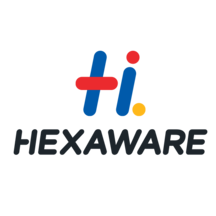 |
Application Modernization Using Containers- 4wk Imp: Hexaware will use its Amaze cloud modernization service to replatform your monolithic application to containerized macroservices or microservices with reduced total cost of ownership. Hexaware’s offering supports Java and .Net applications.
|
 |
AZ-900 Microsoft Azure Fundamentals: 2-Day Workshop: This workshop from Qualitia Energy is suitable for IT personnel who are just beginning to work with Microsoft Azure. Attendees will get hands-on experience to prepare for Exam AZ-900: Microsoft Azure Fundamentals.
|
 |
Azure Episerver Rapid Deploy: 2-Wk Implementation: Kin + Carta’s consultants will work alongside your internal team to rapidly launch and configure your Microsoft Azure environment and deploy Episerver so you can benefit from enhanced agility, elastic scale, and ease of management.
|
 |
Azure Infrastructure Migration: 2-week Assessment: Let Wintellect work with you to migrate your on-premises applications, servers, and databases to Microsoft Azure. In this engagement, Wintellect will review your environment and estimate migration costs.
|
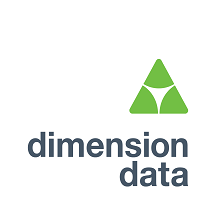 |
Azure Innovation Design Think: 2-day workshop: In this workshop, Dimension Data’s team will identify key opportunities to drive revenue, improve customer retention, and gain competitive business insight through analytics on Microsoft Azure.
|
 |
Azure Migration Consultant – 4 Week Implementation: Inde will use a practical approach based on the Microsoft Cloud Adoption Framework for Azure to discover your requirements, create a safe landing zone, and move your workload to Azure.
|
 |
Azure Transition Framework: 1 day workshop: Moving to Microsoft Azure requires a clear strategic route. In this workshop, Solvinity B.V. will map out that route with its cloud transition framework. This offer is available only in Dutch.
|
 |
Citrix on Azure: 3-Day Readiness Assessment: Are you ready to take advantage of Microsoft Azure for Citrix workloads? Third Octet’s assessment will evaluate your Citrix digital workspace strategy and present you with a high-level summary of findings, cost estimations, and guidelines for the transformation ahead.
|
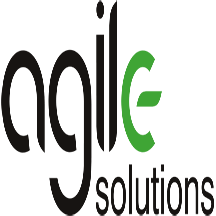 |
Cloud Data Warehouse: Free 1 Day Workshop: A key element of any data strategy on Microsoft Azure is a modern data warehouse. This workshop from Agile Solutions will consider your business requirements and infrastructure, charting a clear path to migrate or rebuild your data warehouse on Azure.
|
 |
Cloud Security Assessment: Two Week Assessment: In this assessment, Logicalis will examine your company’s Microsoft Azure environment, comparing it against best practices for security, performance, agility, scale, and cost. Logicalis will then offer prioritized remediation steps.
|
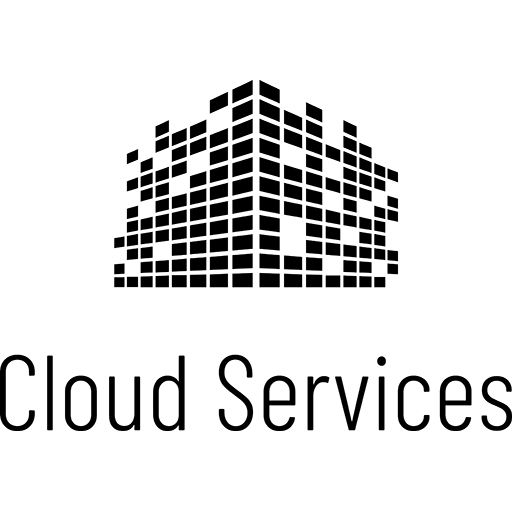 |
Cloud-native 5-Wk App Modernization Implementation: In this implementation, Cloud Services LLC will help chief information officers and chief technology officers modernize their business’s legacy applications by migrating them to Microsoft Azure.
|
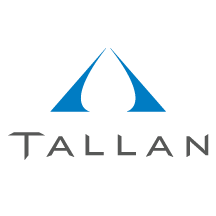 |
Code First in Azure: 3-Week Proof of Concept: Tallan’s offer is designed to help organizations accelerate a technology decision for new application development projects built on Microsoft Azure, and it caters to organizations that need to deliver apps and services in a short time frame.
|
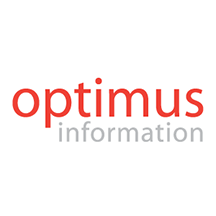 |
Data & AI: 4 Week Proof-of-Concept: Optimus Information will use the Microsoft Cloud Adoption Framework for Azure to jump-start your data and AI journey. Optimus Information will build data pipelines and analytics pipelines for use with Azure, along with reports or dashboards using Microsoft Power BI.
|
 |
Data Strategy on Azure: 4 week Implementation: In this engagement, Agile Solutions will review your strategic vision, underlying data availability, architecture, and data management maturity to help you align your data strategy to your business needs.
|
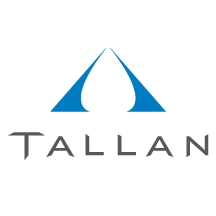 |
Data Strategy: 2 Week Assessment: Tallan will assess your organization’s data strategy to modernize your data management landscape. Tallan’s experts will provide recommendations for Microsoft Azure and will discuss Azure readiness.
|
 |
E2E Managed Network Solutions: Tech Mahindra’s E2E managed services provide a transformation model and approach with key Azure technologies, including IaaS and networking, to help users easily enable services in a hybrid, multi-vendor environment. |
 |
Endpoint Manager Workshop: This workshop from Move AS will teach you how to deploy and implement Microsoft Endpoint Manager in your environment. Endpoint Manager combines several Microsoft services, including Intune, Desktop Analytics, and Windows Autopilot, to keep data secure. |
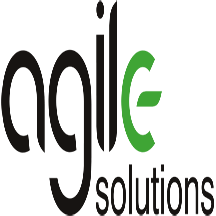 |
Free 1 Day Supplier 360 Workshop- Contact Us Offer: In this workshop, Agile Solutions will identify business use cases, infrastructure requirements, Microsoft Azure architecture, and delivery structure for a fully customized Supplier 360 data management solution.
|
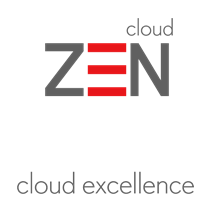 |
Free 8 hours Cloud One Day Workshop: On behalf of Zenith & Company, CLOUDZEN will deliver a free workshop for organizations interested in migrating to Microsoft Azure and needing to make a formal case to senior management. The workshop will present a roadmap to Azure through an understanding of its architecture.
|
 |
GDPR Compliant Cloud Solutions: Learn about GDPR compliance and how to attain it in this workshop from Move AS. The workshop is a good foundation for implementing Microsoft Azure Information Protection and data loss prevention. |
 |
Knowledge Mining: 2-Month Proof of Concept: Companies hold large amounts of data, yet much of it isn’t easily searchable or stored in a structured way. Predica’s proof of concept will use Microsoft Azure AI speech, vision, and language services to transform your company’s raw, unstructured information into searchable content.
|
 |
Manufacturing IoT: 3-Week Proof of Concept (PoC): CloudPro APS’ Microsoft Azure IoT Hub experts will help you plan for an implementation of Azure IoT to gain production insights. The solution will span calibrated telemetry sensors, endpoint devices like mobile phones, and web-based dashboards.
|
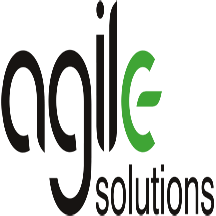 |
Master Data Management: Free 1 Day Workshop: This workshop from Agile Solutions will identify business use cases, infrastructure requirements, Microsoft Azure architecture, and delivery structure for a master data management solution that utilizes Azure Storage and Azure SQL Database.
|
 |
Migrate Dynamics GP to Azure – 2 Hour Briefing: In this briefing, Incremental Group will discuss the process of migrating your on-premises Microsoft Dynamics GP system to Microsoft Azure. Incremental Group’s cloud experts will address any questions you have.
|
 |
Migration Service: 4-Wk Implementation: With information from Microsoft Azure Service Map, which groups applications by risk and complexity, Logicalis will migrate your environment to Azure. Environments will be migrated on an application, database, server, or workload basis, depending on the requirements gathered.
|
 |
Network Transformation Strategy: 4-Wk Assessment: In this assessment, Tech Mahindra will evaluate the customer’s virtual or physical infrastructure, determine the customer’s challenges and desired future state, and identify potential solution strategies to meet the customer’s growth objectives.
|
 |
Oakwood Cloud Ascent Suite: 4-Week Assessment: Oakwood will use its Cloud Ascent Suite to evaluate your use of Microsoft Azure services with the goal of discovering optimization and cost-saving opportunities. Cloud Ascent Suite accelerates Azure migrations by providing in-depth planning and robust price comparison tools.
|
 |
SAP Cloud Readiness 10-Day Assessment: Tech Mahindra will analyze the customer’s SAP environment and assess its cloud readiness. Tech Mahindra aims to eliminate any surprises about product compatibility or migration strategy that may surface when a customer embarks on a cloud transformation journey.
|
 |
SAP on Azure – 2 weeks Assessment: In this engagement, Span d.o.o. will conduct a comprehensive assessment of your SAP landscape and provide recommendations for system architecture that will result in a modernized and cost-optimized environment on Microsoft Azure.
|
 |
SAP on Azure Landscape Review Workshop: 1 Day: This workshop from Dimension Data will guide technology managers and executives through approaches for migrating their SAP estate to Microsoft Azure. The workshop will consider potential pitfalls and conduct a landscape review to establish a business case for migration.
|
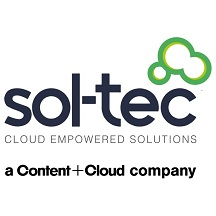 |
Velocity Discovery Workshop Standard – 4 Hours: Sol-Tec’s workshop will help you understand the different offerings of Microsoft Azure and how Azure can support and transform your business. You’ll leave prepared for your cloud journey, with clear steps to follow.
|
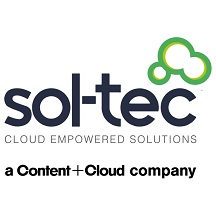 |
Velocity Landing Zone – 2 Hour Evaluation Workshop: In this free consultation, Sol-Tec’s Microsoft Azure architects and delivery consultants will help you understand how Sol-Tec can design and deploy your Azure landing zone.
|
 |
Virtual Workplace: 2-Days Implementation: Experts from Matrix3D will move your IT infrastructure to Microsoft Azure with a practical approach designed for small businesses. Enable your employees to collaborate regardless of their work location.
|
 |
Windows Autopilot: In this engagement, Move AS will deliver a proof of concept of Windows Autopilot, a Microsoft product used to set up and pre-configure new devices. Move AS will map the technical components within Windows AutoPilot, configure a Windows AutoPilot profile, and give a brief demo. |
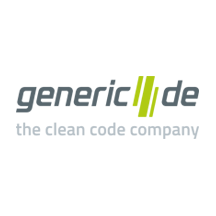 |
Your Clean Code MVP: 10-week implementation: Through an architecture workshop and the principles of clean code development, generic.de will use your product vision to create a sustainable prototype on Microsoft Azure. This offer is available only in German.
|
|

by Scott Muniz | Aug 10, 2020 | Alerts, Microsoft, Technology, Uncategorized
This article is contributed. See the original author and article here.
What is the built-in vulnerability assessment tool in Azure Security Center?
If you’re using Security Center’s standard tier for VMs, you can quickly deploy a vulnerability assessment solution powered by Qualys with no additional configuration or extra costs.

Qualys’s scanner is the leading tool for identifying vulnerabilities in your Azure virtual machines. Once this integration is enabled, Qualys continually assesses all the installed applications on a virtual machine to find vulnerabilities and presents its findings in the Security Center console. This offering is available to all commercial Azure customers that have enabled Azure Security Center standard pricing tier for VMs. In this post, I will focus on vulnerability scanning of virtual machines, although standard tier also offers scanning for both containers and container registries – learn more here.
How does the integration work?
Our integrated vulnerability scanner is based on 5 different stages: from discovery to findings.
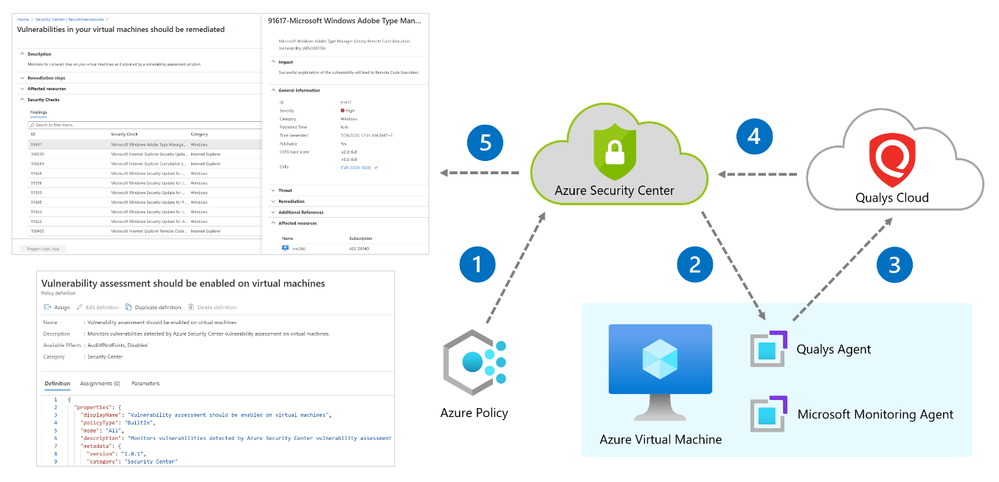
[1] Discovery – To make this integration work, a policy named “vulnerability assessment should be enabled on virtual machines” which is part of the “ASC default” initiative must be enabled. Upon Azure Policy evaluation, we get the compliance data to identify potential and supported virtual machines which don’t have a vulnerability assessment solution deployed. Based on the result, we propagate the data into the recommendation so you can see all relevant virtual machines. Based on compliance data, we categorize the virtual machines as one of the following:
- “healthy” – VMs that have the extension installed and report data.
- “unhealthy” – VMs which could support the extension, but which currently don’t have it.
- “not applicable” – Where the OS type/image is not supported (for example, a virtual machine running Network Virtual Appliance (NVA), Databricks/AKS instances or Classic VMs).
[2] Deployment – This is the step where you can enable the integrated ASC vulnerability scanner by deploying the extension on your selected virtual machine/s either by using ASC console and quick fix button, or by using an automated method (see a reference below for deployment at scale).
Prerequisites for deploying the extension:
- Running VM with a supported operating system version as mentioned here.
- Azure VM agent installed and in healthy state.
- Log Analytics agent installed (formerly known as the Microsoft Monitoring Agent).
- To install using the quick fix option, you’ll need write permissions for any VM on which you want to deploy the extension. Like any other extension, this one runs on top of the Azure Virtual Machine agent.
Once all prerequisites are met, you should use our newly and consolidated recommendation “A vulnerability assessment solution should be enabled on your virtual machines”. In this recommendation, you can choose to deploy ASC integrated vulnerability scanner or 3rd party scanner (BYOL).

This recommendation installs the extension on unhealthy machines. Review the heathy and not applicable lists too.

Once the extension is deployed, you can see if it exists, by navigating to the VM page of the Azure portal, and selecting “extensions”:
- On Windows, the extension is called “WindowsAgent.AzureSecurityCenter” and the provider name is “Qualys”
- On Linux, the extension is called LinuxAgent.AzureSecurityCenter and the provider name is “Qualys”

Like the Log Analytics agent itself and all other Azure extensions, minor updates of the vulnerability scanner may automatically happen in the background; the VA agent is self-healing and self-updating to counter common issues. All agents and extensions are tested extensively before being automatically deployed. On a virtual machine (on Windows for example), you will see a process QualysAgent.exe and service “Qualys Cloud Agent” running:

When deploying a vulnerability assessment solution, Security Center previously performed a validation check before deploying. The check was to confirm a marketplace SKU of the destination virtual machine.
Recently, the check was removed and you can now deploy vulnerability assessment tools to ‘custom’ Windows and Linux machines. Custom images are ones that you’ve modified from the marketplace defaults.
[3] Scan – The gathered data collected by the agent includes many things for the baseline snapshot like network posture, operating system version, open ports, installed software, registry info, what patches are installed, environment variables, and metadata associated with files. The agent stores a snapshot on the agent host to quickly determine differences to the host metadata it collects. Such scans occur every 4 hours and are performed per VM, where artifacts are collected and sent for analysis to the Qualys Cloud service in the defined region. For virtual machines created within European regions, the gathered information is sent securely to Qualys Cloud Service in the Netherlands. For all non-EU resources, data is sent for processing in the Qualys Cloud Service in the US.
The sent artifacts are considered as metadata and the same as the ones collected by Qualys’ standalone cloud agent – Microsoft doesn’t share customer details or any sensitive data with Qualys.
[4] Analysis – Qualys analyzes the metadata, registry keys, and other information and builds the findings per VM. Findings are sent to Azure Security Center matching customer’s ID and are removed from the Qualys Cloud.
[5] Findings – You can monitor vulnerabilities on your virtual machines as discovered by the ASC vulnerability scanner using a recommendation named “Vulnerabilities in virtual machines should be remediated” found under the recommendations list. This recommendation is divided to the affected resources and security checks (also known as nested recommendations or sub-assessments).
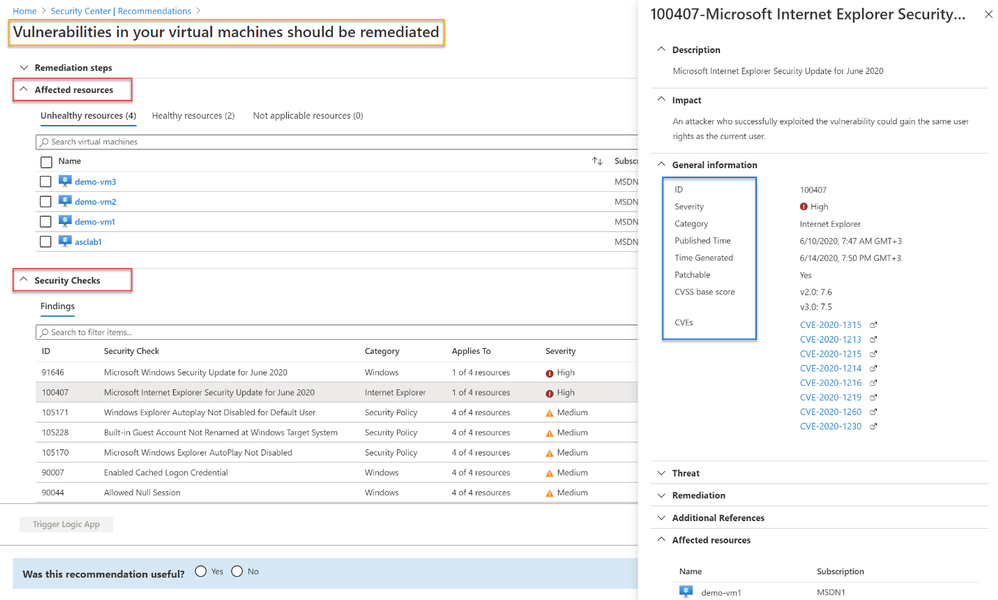
On the affected resources section, you will find virtual machines categorized as unhealthy, healthy, and not applicable. The section named “Security Checks” shows the vulnerabilities found on the unhealthy resource. Findings are categorized by severity (high, medium, and low). Below, you can see the matching between ASC severity on the left and Qualys’ severities on the right:
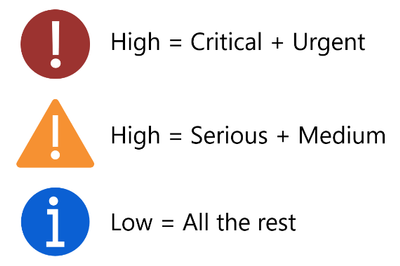
If you are looking for a specific vulnerability, you can use the search field to filter the items based on ID or security check title. Selecting a security check, will open a window containing the vulnerability name, description, the impact on your resources, severity, if this could be resolved by applying patch, the CVSS base score (when the highest is the most severe one), relevant CVEs. Then, you will also find the threat, remediation steps, additional references (if applicable) and the affected resource. Once you remediate the vulnerability on the affected resource, it will be removed from the recommendation page.
Deployment at scale
If you have large number of virtual machines and would like to automate deployment at scale of the ASC integrated scanner, we’ve got you covered! There are several ways to accomplish such deployment based on your business requirements. Some customers prefer to automate deployment by executing an ARM template, others prefer automation using Azure Automation or Azure Logic Apps and others by using Azure Policy for both automation and compliance. For all these scenarios and even beyond, we encourage you to visit our ASC GitHub community repository. There, you can find scripts, automations and other useful resources you can leverage throughout your ASC deployment. Some of the methods will deploy the extension on new machines, others cover existing ones as well. There are other scenarios where customers prefer to make API calls to trigger an installation. This is also possible by executing a PUT call to one of our REST APIs, passing the resource ID to the URL. You can also decide to combine multiple approaches.
Troubleshooting
Below you will find a checklist for your initial troubleshooting if you experience issues related to the ASC vulnerability scanner:
- Are you running a supported OS version? Use the following list to quickly identify if your VMs are running a supported operating system version.
- Is the extension successfully deployed? Monitor VA extension health across subscriptions using Azure Resource Graph (ARG). ARG becomes handy if you want to validate the extension status across subscriptions is heathy for both Linux and Windows machines. Use the following query:
where type == "microsoft.compute/virtualmachines/extensions"
| where name matches regex "AzureSecurityCenter"
| extend ExtensionStatus = tostring(properties.provisioningState),
ExtensionVersion = properties.typeHandlerVersion,
ResourceId = id,
ExtensionName = name,
Region = location,
ResourceGroup = resourceGroup
| project ResourceId, ExtensionName, Region, ResourceGroup, ExtensionStatus, ExtensionVersion

Results can be exported into CSV or used to build an Azure Monitor workbook.
- Is the service running? On Windows VMs, make sure “Qualys Cloud Agent” is running. On Linux, run the command sudo service qualys-cloud-agent
- Unable to communicate with Qualys? To communicate with the Qualys Cloud, the agent host should reach the service platform over HTTPS port 443 for the following IP addresses:
- 64.39.104.113
- 154.59.121.74
Check network access and ensure to accept the platform URL listed.
- Looking for logs? Both agent and extension logs can be used during troubleshooting. However, Windows and Linux logs can be found in different places. Here are the paths:
Windows:
- Qualys extension:
- C:Qualys.WindowsAgent.AzureSecurityCenter
- C:WindowsAzureLogsPluginsQualys.WindowsAgent.AzureSecurityCenter
- Qualys agent:
- %ProgramData%QualysQualysAgent
Linux:
- Qualys extension:
- /var/log/azure/Qualys.LinuxAgent.AzureSecurityCenter
- Qualys agent:
- /var/log/qualys/qualys-cloud-agent.log
Advanced scenarios
Qualys assessment and sub-assessments (security checks) are stored and available for query in Azure Resource Graph (ARG) as well as through the API. A great example for that is available in this blog post. Moreover, you can also build and customize your own dashboards using Azure Monitor workbooks and create such dashboard for more insights. You can easily deploy a Qualys dashboard leveraging ARG queries and workbooks which is available . Soon, you will be able to use Continuous Export feature to send nested recommendations for Qualys into Event Hub or Log Analytics workspaces.
On the roadmap
- Availability for non-Azure virtual machines
- Support for proxy configuration
- Filtering vulnerability assessment findings by different criteria (e.g. exclude all low severity findings / exclude non-patchable findings / excluded by CVE / and more)
- More items are work in progress.
Frequently asked questions
Question: Does the built-in integration support both Azure VMs and non-Azure VMs?
Answer: Our current integration only supports Azure VMs. As mentioned in the roadmap section, we do have plans to support non-Azure virtual machines in the future.
Question: Does the built-in vulnerability assessment as part of standard pricing tier also integrate into the Qualys Dashboard offering?
Answer: Vulnerability assessments performed by our built-in integration is only available through Azure portal and Azure Resource Graph.
Question: Is it possible to initiate a manual/on-demand scan?
Answer: Scan on Demand is a single use execution that is initiated manually on the VM itself, using locally or remotely executed scripts or GPO, or from software distribution tools at the end of a patch deployment job. To do so, the following command will trigger an on-demand metadata sync:
REG ADD HKLMSOFTWAREQualysQualysAgentScanOnDemandVulnerability /v "ScanOnDemand" /t REG_DWORD /d "1" /f
Question: I purchased a separate Qualys/Rapid 7 license, which recommendation should I use?
Answer: We provide additional method for customers who have purchased VA scanner separately and do not use the integrated solution. To enable 3rd-party integration, use “A vulnerability assessment solution should be enabled on your virtual machines” – this recommendation appears for both standard and free tiers. Then, select “Configure a new third-party vulnerability scanner (BYOL – requires a separate license)”. For this kind of integration, you’ll need to purchase a license for your chosen solution separately. Supported solutions report vulnerability data to the partner’s management platform. In turn, that platform provides vulnerability and health monitoring data back to Security Center.
Question: Can I combine two Qualys installation approaches so that the same VM has both the integrated scanner and the BYOL agent installed?
Answer: No, this is not supported. You can’t combine additional deployment approaches of VA while using the built-in VA capabilities provided by ASC.
In the next blog posts, we will discuss on how you can leverage integration for container and container registry images. Stay tuned!
Reviewers:
- Melvyn Mildiner – Senior Content Developer
- Ben Kliger – Senior PM Manager
- Aviv Mor – Senior Program Manager
- Nomi Gorovoy – Software Engineer
by Scott Muniz | Aug 9, 2020 | Alerts, Microsoft, Technology, Uncategorized
This article is contributed. See the original author and article here.
Last time we look at how to get started with GraphQL on dotnet and we looked at the Azure App Service platform to host our GraphQL server. Today we’re going to have a look at a different approach, using Azure Functions to create run GraphQL in a Serverless model. We’ll also look at using JavaScript (or specifically, TypeScript) for this codebase, but there’s no reason you couldn’t deploy a dotnet GraphQL server on Azure Functions or deploy JavaScript to App Service.
Getting Started
For the server, we’ll use the tooling provided by Apollo, specifically their server integration with Azure Functions, which will make it place nicely together.
We’ll create a new project using Azure Functions, and scaffold it using the Azure Functions Core Tools:
func init graphql-functions --worker-runtime node --language typescript
cd graphql-functions
If you want JavaScript, not TypeScript, as the Functions language, change the --language flag to javascript.
Next, to host the GraphQL server we’ll need a Http Trigger, which will create a HTTP endpoint in which we can access our server via:
func new --template "Http Trigger" --name graphql
The --name can be anything you want, but let’s make it clear that it’s providing GraphQL.
Now, we need to add the Apollo server integration for Azure Functions, which we can do with npm:
npm install --save apollo-server-azure-functions
Note: if you are using TypeScript, you need to enable esModuleInterop in your tsconfig.json file.
Lastly, we need to configure the way the HTTP Trigger returns to work with the Apollo integration, so let’s open function.json within the graphql folder, and change the way the HTTP response is received from the Function. By default it’s using a property of the context called res, but we need to make it explicitly return be naming it $return:
{
"bindings": [
{
"authLevel": "function",
"type": "httpTrigger",
"direction": "in",
"name": "req",
"methods": ["get", "post"]
},
{
"type": "http",
"direction": "out",
"name": "$return"
}
],
"scriptFile": "../dist/graphql/index.js"
}
Implementing a Server
We’ve got out endpoint ready, it’s time to start implementing the server, which will start in the graphql/index.ts file. Let’s replace it with this chunk:
import { ApolloServer, gql } from "apollo-server-azure-functions";
const typeDefs = gql`
type Query {
graphQLOnAzure: String!
}
`;
const resolvers = {
Query: {
graphQLOnAzure() {
return "GraphQL on Azure!";
}
}
};
const server = new ApolloServer({ typeDefs, resolvers });
export default server.createHandler();
Let’s talk about what we did here, first up we imported the ApolloServer which is the server that will handle the incoming requests on the HTTP Trigger, we use that as the very bottom by creating the instance and exporting the handler as the module export.
Next, we imported gql, which is a template literal that we use to write our GraphQL schema in. The schema we’ve created here is pretty basic, it only has a single type, Query on it that has a single member to output.
Lastly, we’re creating an object called resolvers, which are the functions that handle the request when it comes in. You’ll notice that this object mimics the structure of the schema we provided to gql, by having a Query property which then has a function matching the name of the available queryable values.
This is the minimum that needs to be done and if you fire up func start you can now query the GraphQL endpoint, either via the playground of from another app.
Implementing our Quiz
Let’s go about creating a more complex solution, we’ll implement the same Quiz that we did in dotnet.
We’ll start by defining the schema that we’ll have on our server:
const typeDefs = gql`
type Quiz {
id: String!
question: String!
correctAnswer: String!
incorrectAnswers: [String!]!
}
type TriviaQuery {
quizzes: [Quiz!]!
quiz(id: String!): Quiz!
}
schema {
query: TriviaQuery
}
`;
Now we have two types defined, Quiz and TriviaQuery, then we’ve added a root node to the schema using the schema keyword and then stating that the query is of type TriviaQuery.
With that done, we need to implement the resolvers to handle when we request data.
const resolvers = {
TriviaQuery: {}
};
This will compile and run, mostly because GraphQL doesn’t type check that the resolver functions are implemented, but you’ll get a bunch of errors, so instead we’ll need implement the quizzes and quiz resolver handlers.
Handling a request
Let’s implement the quizzes handler:
const resolvers = {
TriviaQuery: {
quizzes: (parent, args, context, info) => {
return null;
}
}
};
The function will receive 4 arguments, you’ll find them detailed on Apollo’s docs, but for this handler we really only need one of them, context, and that will be how we’ll get access to our backend data source.
For the purposes of this blog, I’m skipping over the implementation of the data source, but you’ll find it on my github.
const resolvers = {
TriviaQuery: {
quizzes: async (parent, args, context, info) => {
const questions = await context.dataStore.getQuestions();
return questions;
}
}
};
You might be wondering how the server knows about the data store and how it got on that context argument. This is another thing we can provide to Apollo server when we start it up:
const server = new ApolloServer({
typeDefs,
resolvers,
context: {
dataStore
}
});
Here, dataStore is something imported from another module.
Context gives us dependency injection like features for our handlers, so they don’t need to establish data connections themselves.
If we were to open the GraphQL playground and then execute a query like so:
query {
quizzes {
question
id
correctAnswer
incorrectAnswers
}
}
We’ll get an error back that Quiz.correctAnswer is a non-null field but we gave it null. The reason for this is that our storage type has a field called correct_answer, whereas our model expects it to be correctAnswer. To address this we’ll need to do some field mapping within our resolver so it knows how to resolve the field.
const resolvers = {
TriviaQuery: {
quizzes: async (parent, args, context, info) => {
const questions = await context.dataStore.getQuestions();
return questions;
}
},
Quiz: {
correctAnswer: (parent, args, context, info) => {
return parent.correct_answer;
},
incorrectAnswers: (parent, args, context, info) => {
return parent.incorrect_answers;
}
}
};
This is a resolver chain, it’s where we tell the resolvers how to handle sub-fields of an object and it acts just like a resolver itself, so we have access to the same context and if we needed to do another DB lookup, we could.
Note: These resolvers will only get called if the fields are requested from the client. This avoids loading data we don’t need.
You can go ahead and implement the quiz resolver handler yourself, as it’s now time to deploy to Azure.
Disabling GraphQL Playground
We probably don’t want the Playground shipping to production, so we’d need to disable that. That’s done by setting the playground property of the ApolloServer options to false. For that we can use an environment variable (and set it in the appropriate configs):
const server = new ApolloServer({
typeDefs,
resolvers,
context: {
dataStore
},
playground: process.env.NODE_ENV === "development"
});
For the sample on GitHub, I’ve left the playground enabled.
Deploying to Azure Functions
With all the code complete, let’s look at deploying it to Azure. For this, we’ll use a standard Azure Function running the latest Node.js runtime for Azure Functions (Node.js 12 at the time of writing). We don’t need to do anything special for the Functions, it’s already optimised to run a Node.js Function with a HTTP Trigger, which is all this really is. If we were using a different runtime, like .NET, we’d follow the standard setup for a .NET Function app.
To deploy, we’ll use GitHub Actions, and you’ll find docs on how to do that already written, and I’ve done a video on this as well. You’ll find the workflow file I’ve used in the GitHub repo.
With a workflow committed and pushed to GitHub and our App Service waiting, the Action will run and our application will be deployed. The demo I created is here.
Conclusion
Throughout this post we’ve taken a look at how we can create a GraphQL server running inside a JavaScript Azure Functions using the Apollo GraphQL server, before finally deploying it to Azure.
When it comes to the Azure side of things, there’s nothing different we have to to do run the GraphQL server in Azure Functions, it’s just treated as a HTTP Trigger function and Apollo has nice bindings to allow us to integrate the two platforms together.
Again, you’ll find the complete sample on my GitHub for you to play around with yourself.
This post was originally published on www.aaron-powell.com.
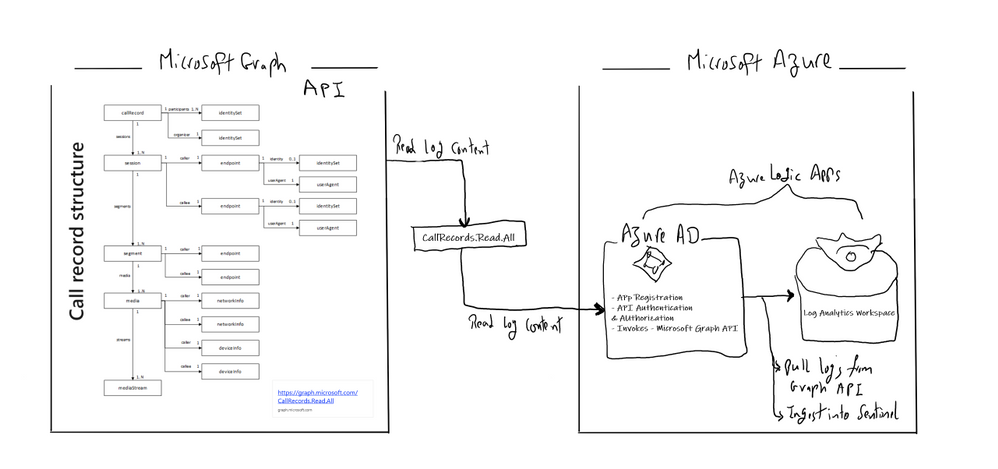
by Scott Muniz | Aug 8, 2020 | Alerts, Microsoft, Technology, Uncategorized
This article is contributed. See the original author and article here.
This blog is authored and technically implemented by @Hesham Saad with hearty thanks to our collaborator and use-cases executive mind brain @yazanouf
Before we dig deep on monitoring TEAMS CallRecords Activity Logs, please have a look at “Protecting your Teams with Azure Sentinel” blog post by @Pete Bryan on how to ingest TEAMS management logs into Azure Sentinel via the O365 Management Activity API
Collecting TEAMS CallRecords Activity Data
This section we will go into details on how to ingest TEAMS CallRecords activity logs into Azure Sentinel via the Microsoft Graph API and mainly leveraging CallRecords API which is a Graph webhook API that will give access to the Calls activity logs. SOC team can subscribe to changes to CallRecords via Azure Sentinel and using the Microsoft Graph webhook subscriptions capability, allowing them to build near-real-time reports from the data or to alert on specific scenarios , use cases which mentioned above.
Technically you can use the call records APIs to subscribe to call records and look up call records by IDs, the call records API is defined in the OData sub-namespace, microsoft.graph.callRecords.
So, what are the key resources types returned by the API ?
| Resource |
Methods |
Description |
| CallRecord |
Get callRecord |
Represents a single peer-to-peer call or a group call between multiple participants |
| session |
Get callRecord
List sessions |
A peer-to-peer call contains a single session between the two participants in the call. Group calls contain one or more session entities. In a group call, each session is between the participant and a service endpoint. |
| segment |
Get callRecord
List sessions |
A segment represents a media link between two endpoints. |
The callRecord entity represents a single peer-to-peer call or a group call between multiple participants, sometimes referred to as an online meeting. A peer-to-peer call contains a single session between the two participants in the call. Group calls contain one or more session entities. In a group call, each session is between the participant and a service endpoint. Each session contains one or more segment entities. A segment represents a media link between two endpoints. For most calls, only one segment will be present for each session, however sometimes there may be one or more intermediate endpoints. For more details click here
Below is the main architecture diagram including the components to deploy Teams CallRecords Activity Logs Connector:

Deployment steps:
Register an App
Create and register Azure AD APP to handle the authentication and authorization to collect data from the Graph API. Here are the steps – navigate to the Azure Active Directory blade of your Azure portal and follow the steps below:
- Click on ‘App Registrations’
- Select ‘New Registration’
- Give it a name and click Register.
- Click ‘API Permissions’ blade.
- Click ‘Add a Permission’.
- Click ‘Microsoft Graph’.
- Click ‘Application Permissions’.
- Search for ‘CallRecords’, Check CallRecords.Read.All. Also, Search for ‘Directory’ and Check Directory.ReadWrite.All and ‘Click ‘Add permissions’.
- Click ‘grant admin consent’.
- Click ‘Certificates and Secrets’.
- Click ‘New Client Secret’
- Enter a description, select ‘never’. Click ‘Add’.
- Note– Click copy next to the new secret and store it somewhere temporarily. You cannot come back to get the secret once you leave the blade.
- Copy the client Id from the application properties and store it.
- Copy the tenant Id from the main Azure Active Directory blade and store it.
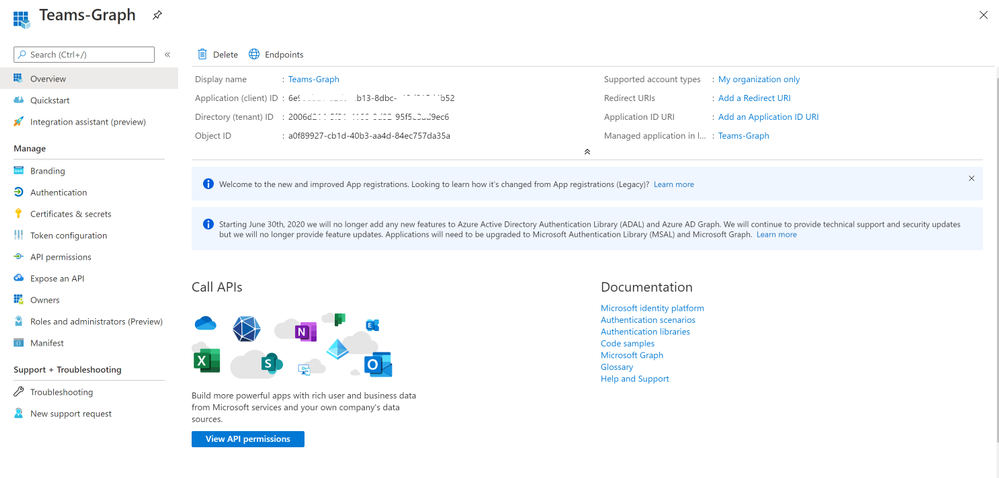
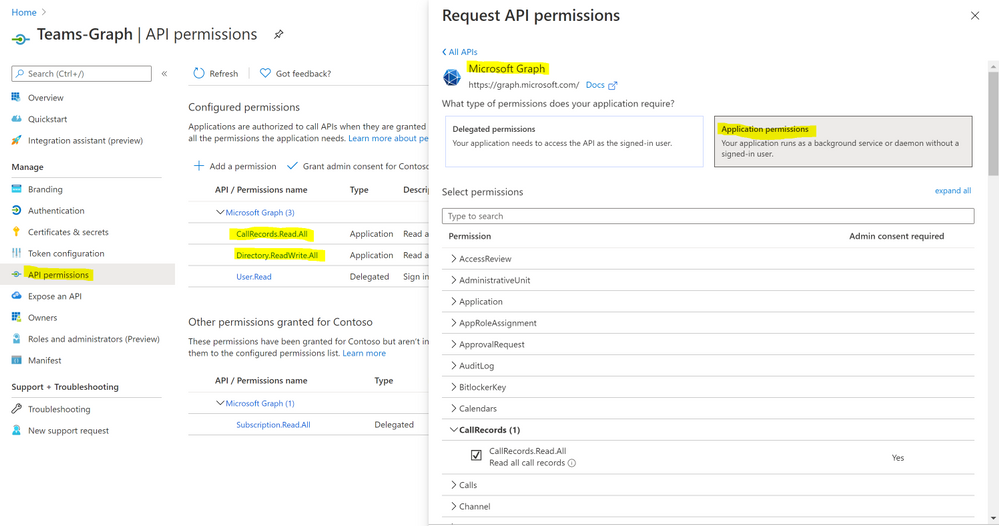

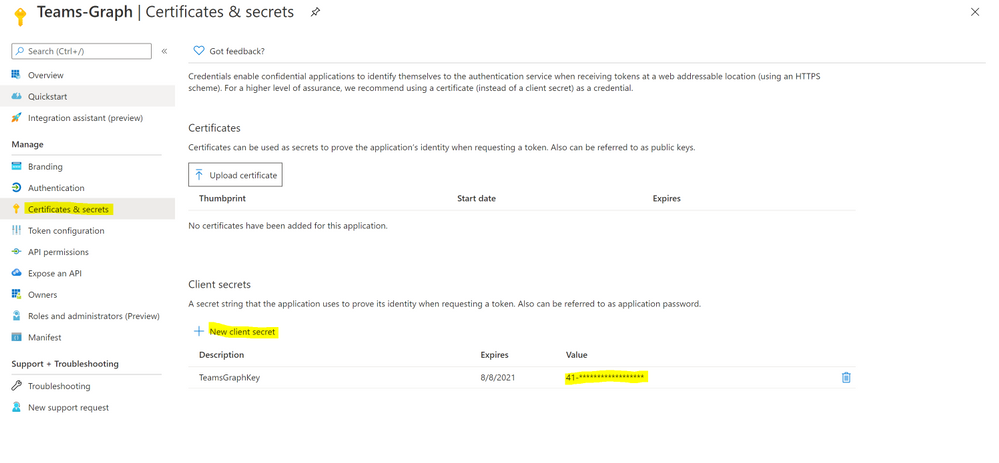
Deploy a Logic App
Last step is to collect the CallRecords activity data and ingest it into Azure Sentinel via a Logic App.
Navigate to Azure Sentinel workspace, click at Playbooks blade and follow the steps below:
- Click on ‘Add Playbook’
- Select ‘Resource Group’, type a name to your logic app for example ‘TeamsCalls-SecurityGraphAPI’ and toggle on ‘Log Analytics’
- Click ‘Review + Create’ then ‘Create’
- Open your new logic app ‘TeamsCalls-SecurityGraphAPI’
- Under ‘Logic app designer’, add the following steps:
- Add ‘Recurrence’ step and set the value to 10 minute for example
- Add ‘HTTP’ step to create CallRecords subscriptions, creating a subscriptions will subscribe a listener application to receive change notifications when the requested type of changes occur to the specified resource in Microsoft Graph, for more details on Create Subscriptions via Microsoft Graph API
- Method: POST
- URI: https://graph.microsoft.com/beta/subscriptions
- Body, note that you can edit ‘changeType’ value with ‘created,updated’ for example, ‘notificationUrl’ is the subscription notification endpoint for more details on notificationUrl
-
{
"changeType": "created",
"clientState": "secretClientValue",
"expirationDateTime": "2022-11-20T18:23:45.9356913Z",
"latestSupportedTlsVersion": "v1_2",
"notificationUrl": "https://outlook.office.com/webhook/3ec886e9-86ef-4c86-bfff-2d0321f3313e@2006d214-5f91-4166-8d92-95f5e3ad9ec6/IncomingWebhook/9c6e121ed--x-x-x-x99939f71721fcbcc7/03c99422-50b0-x-x-x-ea-a00e-2b0b-x-x-x-12d5",
"resource": "/communications/callRecords"
}
- Authentication Type: Active Directory OAuth
- Tenant: with Tenant ID copied above
- Audience: https://graph.microsoft.com
- Client ID: with Client ID copied above
- Credential Type: Secret
- Secret: with Secret value copied above
- Add ‘HTTP’ step to list all subscriptions:
- Method: GET
- URI: https://graph.microsoft.com/v1.0/subscriptions
- Authentication Type: Active Directory OAuth
- Tenant: with Tenant ID copied above
- Audience: https://graph.microsoft.com
- Client ID: with Client ID copied above
- Credential Type: Secret
- Secret: with Secret value copied above
- If you want to get all sessions details per specific call record session ID follow the below steps, noting that the below example is for a single CallRecord Session ID for the sake of demonstration and hence we added a variable item, you can simply add a loop step to get all sessions IDs from the created CallRecords subscription step:
- Method: GET
- URI: https://graph.microsoft.com/beta/communications/callRecords/@{variables(‘TEAMSCallRecordsID’)}/sessions
- Authentication Type: Active Directory OAuth
- Tenant: with Tenant ID copied above
- Audience: https://graph.microsoft.com
- Client ID: with Client ID copied above
- Credential Type: Secret
- Secret: with Secret value copied above
- Add ‘Send TEAMS CallRecords Data to Azure Sentinel LA-Workspace’ step, after doing the connection successfully via your Azure Sentinel Workspace ID & Primary key:
- JSON Request Body: Body
- Custom Log Name: TEAMSGraphCallRecords

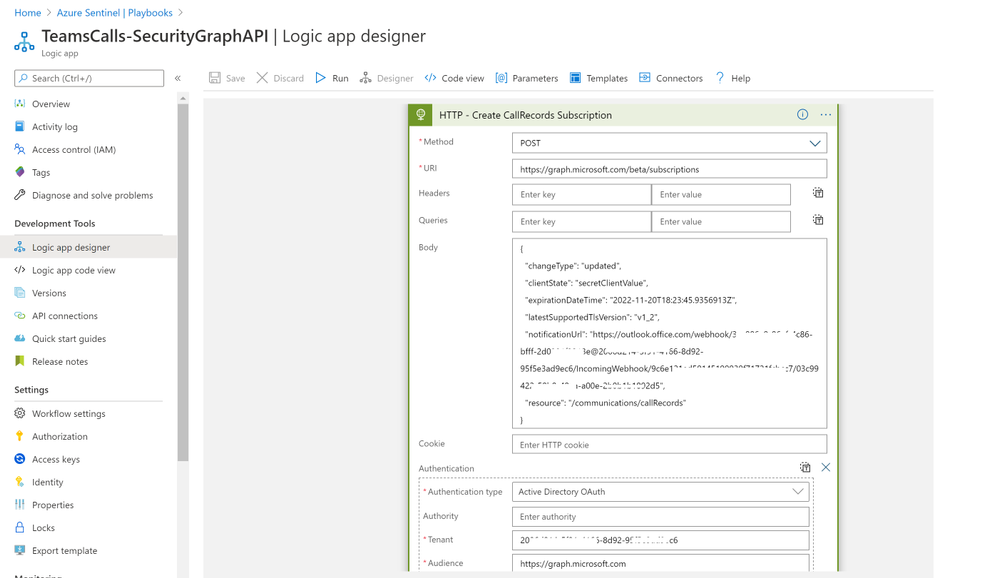
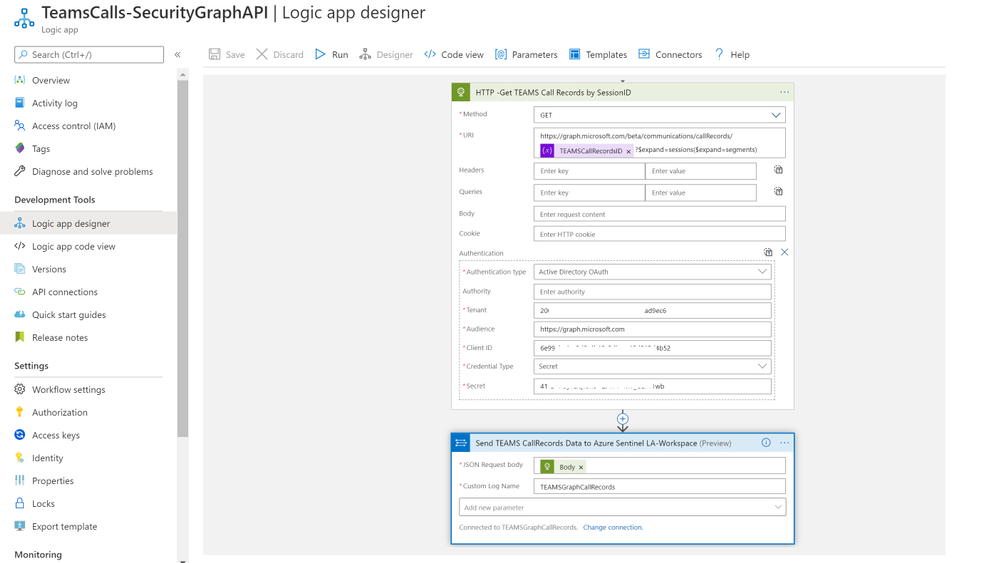
The complete Playbook code view have been uploaded to github repo as well, please click here for more details and check out the readme section.
Monitoring TEAMS CallRecords Activity
When the Playbook run successfully, it will create a new custom log table ‘TEAMSGraphCallRecords_CL’ that will have the CallRecords activity logs, you might wait for a few minutes till the new CL table been created and the CallRecords activity logs been ingested.
Navigate to Azure Sentinel workspace, click at Logs blade and follow the steps below:
- Tables > Group by: Solution > Custom Logs: TEAMSGraphCallRecords_CL
- Below are the list of main attributes that have been ingested:
- TimeGenerated
- Type_s: groupCall
- modalities_s: Audio, Video, ScreenSharing, VideoBasedScreenSharing
- LastModifiedDateTime
- StartDateTime, endDateTime
- joinWebUrl_s
- organizer_user_displayname_s
- participants_s
- sessions_odata_context_s
- As you can see from the results below we get the complete TEAMS CallRecords activity logs.
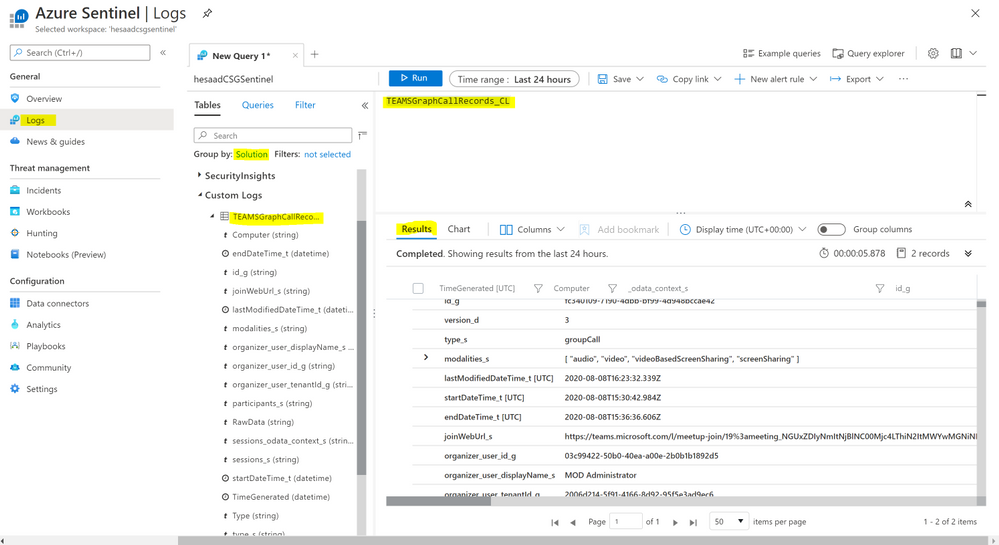
Parsing the Data
Before building any detections or hunting queries on the ingested TEAMS CallRecords Activity data we can parse and normalize the data via a KQL Function to make it easier to use:

The parsing function have been uploaded as well to the github repo.
Part (2): we will share a couple of hunting queries and upload them to github, it’s worth to explore Microsoft Graph API as there are other TEAMS related APIs logs that can be ingested based on the requirements and use cases:
- TeamsActivity:
- Read all users’ teamwork activity feed
- TeamsAppInstallation:
- Read installed Teams apps for all chats
- Read installed Teams apps for all teams
- Read installed Teams apps for all users
- TeamsApp
- Read all users’ installed Teams apps
…etc
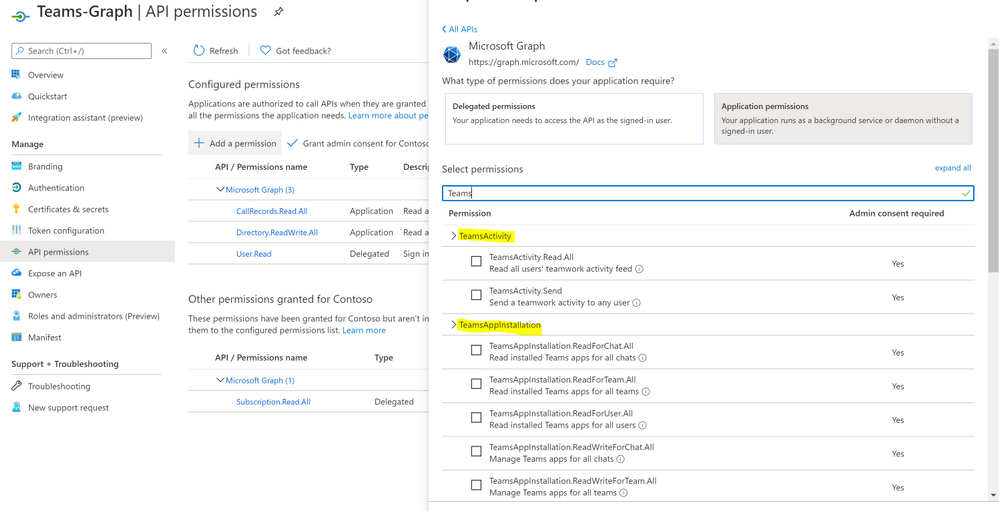
We will be continuing to develop detections and hunting queries for Microsoft 365 solutions data over time so make sure you keep an eye on GitHub. As always if you have your own ideas for queries or detections please feel free to contribute to the Azure Sentinel community.






Recent Comments